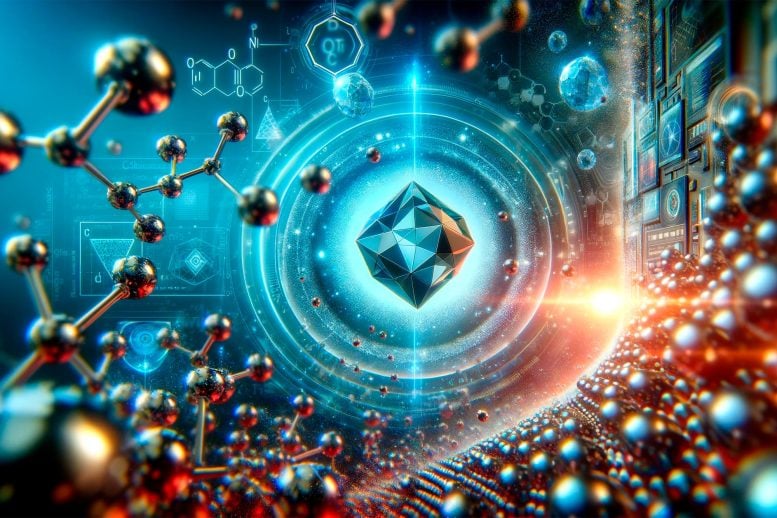
Scientists have solved a decades-long puzzle and unveiled a near unbreakable substance that could rival diamond, as the hardest material on earth, a study says.
Researchers found that when carbon and nitrogen precursors were subjected to extreme heat and pressure, the resulting materials – known as carbon nitrides – were tougher than cubic boron nitride, the second hardest material after diamond.
Unlocking the Potential of Carbon Nitrides
The breakthrough opens doors for multifunctional materials to be used for industrial purposes including protective coatings for cars and spaceships, high-endurance cutting tools, solar panels, and photodetectors, experts say.
Materials researchers have attempted to unlock the potential of carbon nitrides since the 1980s, when scientists first noticed their exceptional properties, including high resistance to heat.
Yet after more than three decades of research and multiple attempts to synthesize them, no credible results were reported.
International Collaboration Leads to Success
Now, an international team of scientists – led by researchers from the Centre for Science at Extreme Conditions at the University of Edinburgh and experts from the University of Bayreuth, Germany and the University of Linköping, Sweden – have finally achieved a breakthrough.
The team subjected various forms of carbon-nitrogen precursors to pressures of between 70 and 135 gigapascals – around one million times our atmospheric pressure – while heating it to temperatures of more than one and a half thousand degrees Celsius.
To identify the atomic arrangement of the compounds under these conditions, the samples were illuminated by an intense X-ray beam at three particle accelerators – the European Synchrotron Research Facility in France, the Deutsches Elektronen-Synchrotron in Germany, and the Advanced Photon Source based in the United States.
Implications of the New Discovery
Researchers discovered that three carbon nitride compounds were found to have the necessary building blocks for super-hardness.
Remarkably, all three compounds retained their diamond-like qualities when they returned to ambient pressure and temperature conditions.
Further calculations and experiments suggest the new materials contain additional properties including photoluminescence and high energy density, where a large amount of energy can be stored in a small amount of mass.
Researchers say the potential applications of these ultra-incompressible carbon nitrides are vast, potentially positioning them as ultimate engineering materials to rival diamonds.
The research, published in Advanced Materials, was funded by the UKRI FLF scheme and European research grants.
Dr. Dominique Laniel, Future Leaders Fellow, Institute for Condensed Matter Physics and Complex Systems, School of Physics and Astronomy, University of Edinburgh, said: “Upon the discovery of the first of these new carbon nitride materials, we were incredulous to have produced materials researchers have been dreaming of for the last three decades. These materials provide strong incentive to bridge the gap between high-pressure materials synthesis and industrial applications.”
Dr. Florian Trybel, Assistant Professor, Department of Physics, Chemistry and Biology, University of Linköping, said: “These materials are not only outstanding in their multi-functionality, but show that technologically relevant phases can be recovered from a synthesis pressure equivalent to the conditions found thousands of kilometers in the Earth’s interior. We strongly believe this collaborative research will open up new possibilities for the field.”
Reference: “Synthesis of Ultra-Incompressible and Recoverable Carbon Nitrides Featuring CN4 Tetrahedra” by Dominique Laniel, Florian Trybel, Andrey Aslandukov, Saiana Khandarkhaeva, Timofey Fedotenko, Yuqing Yin, Nobuyoshi Miyajima, Ferenc Tasnádi, Alena V. Ponomareva, Nityasagar Jena, Fariia Iasmin Akbar, Bjoern Winkler, Adrien Néri, Stella Chariton, Vitali Prakapenka, Victor Milman, Wolfgang Schnick, Alexander N. Rudenko, Mikhail I. Katsnelson, Igor A. Abrikosov, Leonid Dubrovinsky and Natalia Dubrovinskaia, 11 October 2023, Advanced Materials.
DOI: 10.1002/adma.202308030
2 Comments
“New Near Unbreakable Material Rivals Diamond in Hardness”
Contrary to popular misconceptions, diamonds are not even close to being indestructible. They have the highest resistance to scratching of any known material, and can scratch everything else. However, they will break along certain preferred directions — called cleavage planes — with relative ease. That means they can be crushed and reduced to powder.
Just review the data again. It’s probably nothing.